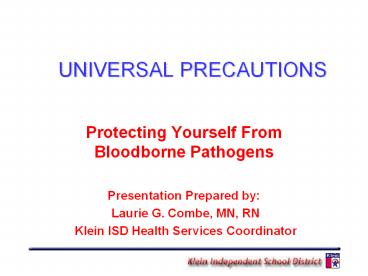UNIVERSAL PRECAUTIONS PowerPoint PPT Presentation
1 / 24
Title: UNIVERSAL PRECAUTIONS
1
UNIVERSAL PRECAUTIONS
- Protecting Yourself From Bloodborne Pathogens
- Presentation Prepared by
- Laurie G. Combe, MN, RN
- Klein ISD Health Services Coordinator
2
How Do I Know When To Be Careful?
- Every contact should be considered potentially
harmful, because not everyone knows they are ill
or is willing to share their health information.
3
How Do I Know When To Be Careful?
- Take precautions every time you are in contact
with the body fluids or tissues of another
person.
4
Potential Sources Of Infection
- Blood
- Vomit
- Mucous
- Urine
- Feces
- Body tissues
- Saliva
- Torn or loose skin
- Genital secretions
5
How Do Germs/Pathogens Enter My Body?
- Open cuts scratches
- Abrasions or scrapes
- Dermatitis
- Acne
- Mucous membranes of mouth, eyes, nose
6
Hepatitis B Can Survive On Environmental
Surfaces For Up To One Week
7
Hepatitis B - Modes Of Transmission
- Contact with contaminated surfaces
- Eyes
- Mouth
- Broken Skin
- Tattoo
- Body Piercing
- Shared razor, earrings, toothbrush
- Sexual Contact
8
HIV - Modes Of Transmission
- Not a very resilient virus
- Sexual contact
- Blood
- Some body fluids
- Body tissues
9
Hepatitis A - Modes Of Transmission
- Fecal - oral route
- Improper food handling
- Clothing
- Raw, contaminated shellfish
- Poor hand washing after restroom use
10
Hepatitis C - Modes Of Transmission
- Blood
- Transfusion
- Organ transplant
11
Where Can I Find These Pathogens?
- Hands
- Desks
- Floors
- Scissors
- Exacto Blades
- Door knobs
- Books
- Diapers
- Broken glass
- Sharp metal
- Needles
- Knives
- Orthodontic wires
- Restroom surfaces
- And more
12
How Do I Prevent Transmission?
- Hand washing vigorously for at least 20 seconds
with soap and warm water - Gloves
- Disinfect with KISD approved cleaners
- Double bag contaminated articles
- Remove contaminated materials from work area ASAP
- Dispose of sharps in appropriate container
13
Soap and Water Hand Washing
- Wet hands with warm water
- Apply soap
- For at least 20 seconds, rub hands together,
making sure to spread soap foam on palms, between
fingers, fingertips and backs of hands - Rinse hands under running water
- Pat hands dry with paper towels
- Turn of water using paper towel to prevent
recontamination of hands
14
Hand Sanitizers Use
- Apply a dime sized portion of hand sanitizer to
the palm of your hand - Wet the fingertips of each hand with the
sanitizer - Rub hands palm to palm, between fingers, and the
back of hands - Continue rubbing until your hands are dry
15
To prevent illness wash hands frequently and
- BEFORE
- You eat
- Treat a break in skin
- Care for ill person/animal
- Insert or remove contact lenses
- AFTER
- Use restroom
- Handle uncooked foods
- Change a diaper
- Sneeze, cough or blow your nose
- Handle garbage
- Care for ill/injured
- Touch an animal
- Remove gloves used as personal protective
equipment
16
Job Specific Exposure Protection Plan
- Refer to the Klein ISD Bloodborne Pathogen
Exposure Control Plan attached to this eCourse to
review your Job Specific Exposure Plan.
17
Job Specific Exposure Plan
- Review you exposure plan to determine
- What work tasks put you at risk
- Safe work practices
- Personal Protective Equipment you should use
18
What To Do If You Are Exposed?
- Report to your supervisor
- Report to campus school nurse
- If needed, complete Workmans Comp form and KISD
Employee Exposure Report. - Take reports to your doctor.
- Give copy of report to your supervisor.
19
Where Can I Find the KISD Bloodborne Pathogen
Plan?
- http//knet/handbooks/bloodexpos.pdf
- Attached to this eCourse
- Principal Secretarys Office
- Department Offices
- School Clinic
20
REVIEW...
- Consider every contact potentially harmful.
- Wash your hands frequently.
- Personal Protective Equipment
- Report exposures to your supervisor
- Report to campus school nurse
- Complete Workmans Comp form
- See your doctor
21
QUESTIONS????
- Contact you campus nurse if you have questions
related to the content of this presentation. - If you are not assigned to a school campus,
direct questions to lcombe_at_kleinisd.net.
22
Bibliography
- Bloodborne Pathogen Plan. Klein ISD. (Online)
http//knet/handbooks/bloodexpos.pdf. January,
2001. - Guide to the five types of viral hepatitis.
Harris County Health Department. Circa 1995. - Manual of Information on Acquired
Immunodeficiency Syndrome. Klein Independent
School District. December, 1986. - OSHA Fact Sheets Bloodborne Pathogens Final
Standard. (Online) http//www.osha-slc.gov/OshDo
c/Fact_data/FSNO92-46.html. Jun. 16. 2000. - Persons reported to be living with HIV infection
and with AIDS, by state and age group, reported
through December, 1999. Center For Disease
Control. (Online) http//www.cdc.gov/hiv/stats/ha
sr1102/table 1.htm. Jun. 29, 2000. - Grey Bruce Public Health Unit, Ontario, Canada.
Hand Washing Video
23
Course Completion Confirmation (Print this slide
and turn into campus nurse.)
- My signature below is confirmation that I have
completed Universal Precautions Compliance
Training. - ______________ ______________
- Printed Name Signature
- Date _________________
24
(No Transcript)

